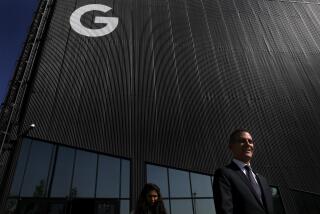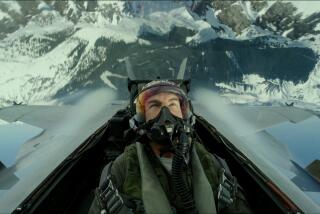Del Mar Avionics Takes New Direction : Technology: The company, rooted in military contracting, turns to manufacturing compact disks as defense industry slumps.
- Share via
IRVINE — Bruce Del Mar has experienced a lifetime of change. An aviation pioneer--he co-invented the pressurized airplane cabin--this Orange County inventor is credited with dozens of technological innovations. And at 81, Del Mar said, he is ready to undergo another conversion.
The defense and medical equipment company that bears his name, Del Mar Avionics, is again shifting focus away from its military-contracting roots--this time to profit from the fast-moving compact disk manufacturing industry. It’s like turning swords into plowshares with a vengeance.
“When you’re like a polar bear on a floating iceberg and it’s melting, you jump to another iceberg,” said Del Mar. “We move our technology to where the market is.”
Del Mar Avionics was on its way toward becoming yet another victim of the defense downturn. But its chairman and founder decided to join the revolution of multimedia--the use of text, video, sound and graphics to create dazzling animation and movie-like effects on personal computers.
By modifying the technology it uses for the medical monitors it makes, the company has devised a cheaper way to create compact disk masters, which are used as templates to mass-produce thousands of copies of compact disks for audio and computer software.
With a name to rival that of any weapons program, Del Mar Avionics’ Fire Trac master system is the company’s latest shot at diversification. It uses a laser, or “fire,” to burn soundtracks onto CDs.
And there is a market for Fire Trac--nearly 100 million software CDs were manufactured in 1993, based on estimates by the Optical Publishing Assn., a trade group based in Columbus, Ohio.
Del Mar Avionics invested $1.5 million last year in its 30-person optical division and expects a sales boost in 1994. Since January, the company has sold five Fire Trac systems, which generate about $500,000 from each customer. This is about a quarter of the $2 million that record companies spend for conventional mastering equipment.
The fight for success isn’t necessarily over, though. Defense companies often fail when seeking commercial applications for their products. The usual culprit, says Santa Ana defense conversion consultant M.L. (Bud) Warrick, is failure to master the skills of marketing to a variety of customers rather than just one--the government.
“A lot of guys think they know what they’re doing,” Warrick said. “Sometimes they have luck if they go into a specialized market where there is a limited number of customers and distribution isn’t as difficult.”
“It’s an adjustment to move into the entertainment world,” Del Mar admits. “We went to one trade show dressed in suits and a lot of people there were showing a lot of bare skin.”
Things were a lot different when Del Mar began working in 1937 for Douglas Aircraft Co., where he and other Douglas scientists designed the pressurized cabin. Using money he got from royalties on his inventions, he started his own company, Del Mar Engineering Laboratories, in 1952, making training systems for aircraft weapons.
In 1975, the company--by then renamed Del Mar Avionics--moved to a 10-acre site in Orange County that was surrounded by orchards and places where Del Mar could go duck hunting. These days, the location is part of Irvine’s industrial district.
A walk through Del Mar Avionics’ lobby, which includes a museum of products from the company’s past, reveals Del Mar’s history of iceberg-hopping. In one area are weapons-training systems that look like big bombs, and a bright orange, helicopter-size freight carrier that was never delivered.
Sensing a chance to expand into the medical business, the company more than 30 years ago started making magnetic tape recorders that monitor the vital signs of hospital patients.
In the 1960s those monitors were housed in 50-pound boxes. Today the same functions are performed by a hand-held device. A stair-climbing exercise machine that was supposed to ride aboard the space shuttle is now gathering dust. The machine broke down before its scheduled trip.
Del Mar Avionics peaked in the early years of the Reagan Administration’s military buildup. It employed 600 people and had revenue of $35 million in 1982. The numbers were down to about 200 employees and revenue of $20 million last year.
Military contracts were a declining part of Del Mar’s sales in the last decade. The company lost a contract for making weapons-range instruments, which tell pilots whether they hit dummy targets. It shed some workers and shifted other workers to new divisions.
About six years ago, the company decided to invest in optical storage, a system that uses lasers to record information on spinning disks similar to but larger than the CDs used in the home. Optical methods could store more information than magnetic tape and so were a natural choice for the hospital monitors.
Using optical technology combines research in chemistry, physics, optics, electronics, software and high-tech manufacturing. That doesn’t come cheap, said David Johnson, vice president and general manager of the company’s laser optics division. Over the last 10 years, the company has invested more than $30 million in research and development.
Its Fire Trac system uses a laser to embed data--which later becomes music, moving picture or text--on a light-sensitive disk in patterns that can be interpreted as the 1s and 0s of computerese. Once recorded, the disk is encased in metal and processed to function as a “stamper,” or mold for disk replication.
The patented Del Mar system helps smaller publishers and manufacturers of CDs stay competitive with and less dependent on a limited number of mastering companies, such as Sony Corp.
Barry Taylor, a manager at Better Quality Cassettes Inc. in Council Bluffs, Iowa, said Fire Trac allowed his company to cut its costs of producing master CDs by 20%.
Warrick, the defense consultant, said Del Mar will have to be ready to deal with a competitive backlash--including price cuts by Sony and other players in the mastering market--as part of the daily routine of commercial sales.
“They can’t just be a one-trick pony and come up with only one product,” he said.
With new sales from Fire Trac and some luck, Del Mar Avionics expects 1994 sales to hit $30 million and employment to grow to 240 people.
“We’re envisioning this as our major growth for the year,” Johnson said.
More to Read
Inside the business of entertainment
The Wide Shot brings you news, analysis and insights on everything from streaming wars to production — and what it all means for the future.
You may occasionally receive promotional content from the Los Angeles Times.









